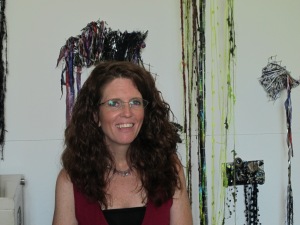Posted on by lvartscouncil
by Randall Forte, LVAC executive director
Meet Arts Council member, Kristin Baxter, assistant professor of art at Moravian College. For more than five years, she taught art to children in kindergarten through grade eight, and she conducted professional development workshops for teachers in museums, galleries, schools, and community centers.
What made you decide to become a professor?
Early in my career as an art educator, I was fortunate to work in a variety of settings with diverse audiences, including preschool children; suburban middle school kids; urban non-English-speaking children; college students; and classroom and art teachers. I believe each of my students, whether we were together for one day or one year, connected the art and museum experiences to his or her own life and gained new appreciation for himself/herself and others. I believe this is how new knowledge within art education can lead to social transformations.
In your opinion, what is the biggest challenge facing art educators today?
To be more effective at advocating for children to have sustained and meaningful art education with certified art specialists throughout the K–12 years. While I believe children can have very meaningful art experiences with classroom teachers or with specialists in other subject areas, it is critical that certified art specialists be retained in (or restored to) all public schools throughout our country.
Oftentimes art specialists appear isolated. How can they integrate themselves more fully into the entire school’s culture?
Build relationships with new colleagues. At Moravian College, I teach “First Year Seminar,” which is a writing/research class and introduction to college life. The theme for my section of this course is “Modern Art History,” which includes visits to museums in New York City. Teaching this class has helped me to learn about college-wide initiatives and ways to integrate them into my courses and to share the importance of art education with colleagues across subject areas.
I have read that your own art builds on personal objects and narrative. How would you describe it?
I use snapshots and found objects as part of my collages and assemblages. Things make the past real. Things bring the past forward. My art practice explores this dynamic nature of static things.
There is often highly charged emotional content associated with objects from daily life. Children’s toy blocks conjure memories of simple play; yet casting them in bronze renders the toys useless for a toddler. My art destabilizes the value of objects just as the memories associated with them shift and fade and, ultimately, mislead. The things we save can possess both pleasing and disturbing narratives at the same time. Through my art practice, I explore this contradiction.
Whose work has influenced you?
Graeme Sullivan, my mentor from Columbia University, has been my biggest influence for my art practice and pedagogy. I also find ideas through novels, children’s books (David Wiesner’s The Three Pigs and Istvan Banyai’s Zoom), and films that challenge assumptions and consider objects as purveyors of memories.
In the film Everything Is Illuminated, the main character, an American, Jonathan, uses a prized family snapshot to lead him on a journey to the Ukraine to seek out knowledge about his grandparents. Along the way, he collects random objects (such as a cricket and soil) and places them in plastic zip-lock bags. He does so in order “not to forget.” This is in contrast to the opinions of Jonathan’s Ukrainian tour guide, Alex, who asserts, “The past is past and all that is not now should remain buried along the side of our memories.” Throughout the film, there is an underlying debate between the need to save objects and memories but also to let things go in order to move forward in our lives. By the end of the film, Alex declares, “Everything is illuminated in the light of the past.” This film shows the ability of snapshots and found objects to both depict and recollect a past, but such images and objects also help us shape our knowledge about ourselves and our future.
As an artist, how do you balance work, life, and time in the studio?
Being a mother and professor in a tenure-track position, I rarely have time to spend “in the studio.” Instead, I make creative moments surround my life, like water filling a jar of stones. I knit whenever I am waiting; I involve my children in my art-making when I can; I go away! Each summer, I plan chunks of time where I am sequestered and making art.


